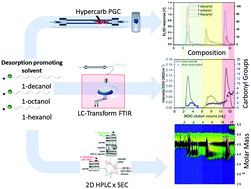Multidimensional chromatographic analysis of carboxylic acid-functionalized polyethylene
Abstract
Carboxylic acid-functionalized polyethylenes derived from acrylic acid and methacrylic acid are difficult to characterize chromatographically owing to their insoluble nature in conventionally used solvents. These functionalized polyolefins are insoluble at ambient temperatures in tetrahydrofuran (THF) at low comonomer contents, and at high temperatures in 1,2,4-tricholorobenzene (TCB) or 1,2-dichlorobenzene (ODCB) at high comonomer contents. As such, there is no unified published technique for the molar mass determination of the full range of carboxylic acid-based and other types of polar functionalized polyolefins. In this study, a binary mixture of TCB and cyclohexanone (80 : 20 v/v) at 140 °C has been found to be suitable for molar mass analysis of ethylene-co-acrylic acid and ethylene-co-methacrylic acid samples. The chemical composition distributions of both low and high comonomer content resins are impossible to be obtained using conventional temperature rising elution fractionation and crystallization analysis fractionation. However, they can be analyzed using a high-temperature solvent gradient technique, utilizing relatively low-viscosity and low-boiling-point decane and 1-hexanol to achieve separation. A significantly improved detection sensitivity in evaporative light scattering detection is observed when the typically used TCB → 1-decanol solvent gradient is replaced by a decane → 1-hexanol gradient. The lower viscosity of this solvent gradient allowed for the use of lower column temperatures (as low as 120 °C). The chemical composition (comonomer) distributions in both high-temperature size exclusion (HT-SEC) and solvent gradient chromatography (HT-SGIC) separations are confirmed by coupling to Fourier transform infrared (FTIR) spectroscopy. Coupling of HT-SGIC to HT-SEC in two-dimensional separations and to FTIR showed that for low acrylic acid contents, low molar mass components elute unretained at 140 °C despite being functionalized. At higher comonomer contents, the detector response in two-dimensional separations was low and requires further optimization.



 Please wait while we load your content...
Please wait while we load your content...